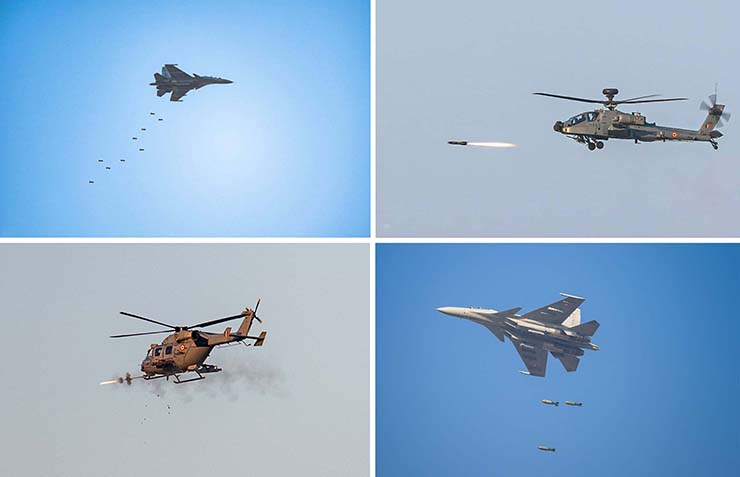
New Delhi: With the country facing the threat of a two-front war with China and Pakistan – the Indian Air Force on February 17 conducted “Exercise Vayu Shakti – 24” at Pokhran near Jaisalmer in Rajasthan and the exercise lasting about two hours and fifteen minutes showcased India’s air power and increasing focus on its avowed “Aatmanirbhar” in defence sector.
On display were India-made platforms such as the Tejas aircraft, Prachand helicopters and Akash and Samar surface-to-air missile systems and the distinguished audience who watched this display included the Chief of Defence Staff General Anil Chauhan, IAF chief Air Chief Marshal VR Chaudhari, navy chief Admiral R Hari Kumar, several top military officials and defence attaches of various countries.
The exercise saw IAF showcasing its offensive capabilities by day and night, with fighter jets carrying out precision strikes against simulated enemy aircraft and targets on the ground, including runways, bridges, ammunition dumps, radar sites, terror camps, thermal power plants and ordnance factories, to ensure superiority in the battlefield.
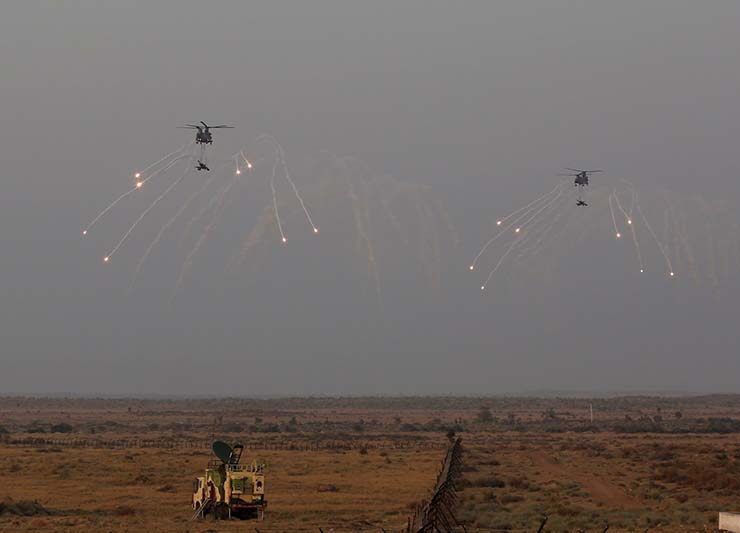
As the IAF said on X, Exercise Vayu Shakti-24, based on the theme Lightning Strike from the Sky, saw IAF’s combat platforms drop around 50 tonnes of ordnance in a span of two hours over an area measuring two square km.
The highlights of the exercise, which involved more than 120 aircraft, included Jaguar fighter jets destroying an ‘ammunition dump’ in a high-speed, low-level strike, Sukhoi- 30s targeting a ‘bridge’, the Rafale deploying its Mica missile to down an enemy jet simulated by a drone, and Apache attack helicopters firing their Hellfire missiles to take out a ‘tank formation’. India-made platforms such as the light combat aircraft Tejas, Prachand light combat helicopters, and Akash and Samar surface-to-air missile systems were among the elements featured in the exercise.
“These attacks were delivered in multiple modes and directions, employing a variety of precision-guided munitions as well as conventional bombs and rockets,” IAF said in a statement.
The highlights of the exercise, which involved more than 120 aircraft, included Jaguar fighter jets destroying an ‘ammunition dump’ in a high-speed, low-level strike, Sukhoi- 30s targeting a ‘bridge’, the Rafale deploying its Mica missile to down an enemy jet simulated by a drone, and Apache attack helicopters firing their Hellfire missiles to take out a ‘tank formation
The Tejas fighters showcased their swing-role capability as they first engaged an aerial target and later a ground target. “Keeping up with the technological advancements in combat domain and the lessons learnt from recent conflicts, lAF also displayed a long-range unmanned drone, which destroyed a simulated enemy radar site with pinpoint accuracy,” the statement said.
Vayu Shakti was last held at Pokhran in February 2019 when fighter planes targeted and destroyed simulated enemy sites, demonstrating IAF’s capability to hit hard, hit fast and hit with precision.
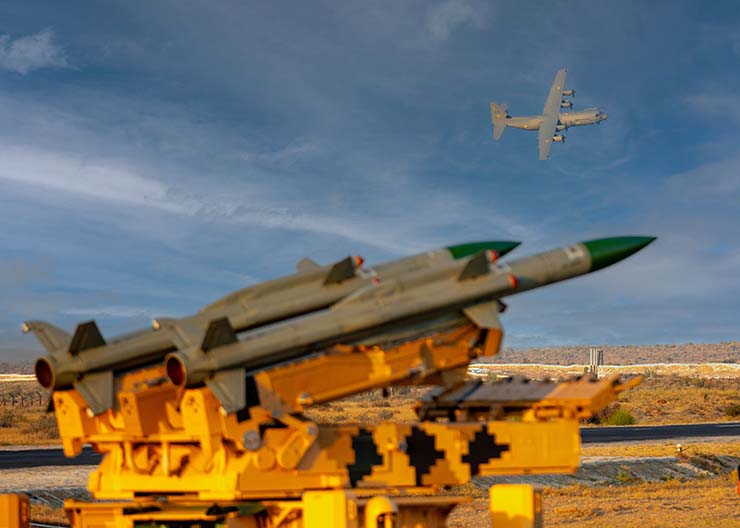
The army’s M777 ultra-light howitzers also fired at targets at Vayu Shakti-24. Chinook helicopters carried these 155 mm/39-calibre howitzers to the Pokhran range as an underslung load. The demonstration of IAF’s capabilities included MiG-29s and Mirage 2000s pounding targets with bombs, Rudra helicopters destroying tanks with their rockets and the C-130J special operations aircraft carrying out an assault landing.
The night element of the exercise involved the Jaguars, Sukhoi-30s, Prachand helicopters, Akash missile system and the M777 howitzers. “The night events displayed for the first time the capabilities of the indigenous Prachand wherein it neutralised the designated target with rockets. This was followed by a Jaguar and Su-30 dropping heavy calibre and area weapons showcasing the strategic bombing capability of the lAF,” the statement said.
Remotely piloted aircraft carried out the damage assessment of all targets that was live-streamed to the operations centre and the audience. The line-up of events included Garud commandos slithering down the Mi-17 helicopter to carry out an ‘urban intervention’, displaying their prowess in operations aimed at clearing terror hideouts.
Keeping up with the technological advancements in combat domain and the lessons learnt from recent conflicts, the lAF also displayed a long-range unmanned drone, which destroyed a simulated enemy radar site, with pinpoint accuracy. An IAF Rafale also successfully engaged an aerial target with a beyond visual range air-to-air missile
In the coming months, IAF will host a mega exercise that is expected to bring together 12 global air forces, with the focus being on improving interoperability, imbibing best practices from one another and boosting military cooperation among the participating countries. Named Tarang Shakti, it will be the biggest multi-nation air exercise to be conducted on Indian soil and will involve fighter jets, transport aircraft, helicopters, mid-air refuellers, airborne warning and control system (AWACS) aircraft, and unmanned systems.
To be sure, while Tarang Shakti will be the biggest multilateral exercise to be conducted in India, IAF has taken part in several such drills on foreign soil. This year IAF will also conduct its pan-India and the largest-of-its-kind exercise, Gagan Shakti, the officials said. In the 2018 edition of Gagan Shakti, the air force clocked more than 11,000 sorties during the two-phase air manoeuvres that saw the concentration of the air force’s deployed assets move from the western sector to the eastern front in less than 48 hours.
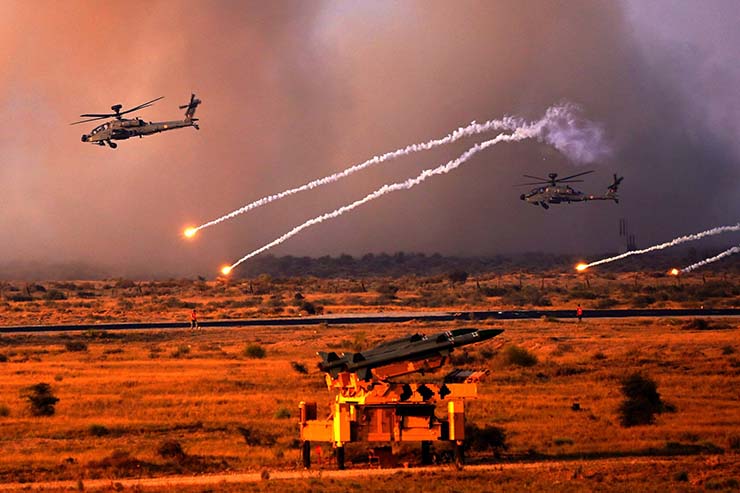
It sought to test the IAF’s readiness and stamina for a two-front war with China and Pakistan. From deep strikes to air dominance and maritime operations to air defence, the IAF practised every manoeuvre in the book in its preparation for a short and intense war.
The event began with three Chetak helicopters trooping the National Flag and the Air Force ensign, flying past the grand stand with the National Anthem playing in the background. This was followed by a perfectly timed ‘Sonic Boom’ created by a Rafale aircraft. Two Jaguar aircraft flying at low levels followed the Rafale, taking high fidelity reconnaissance images of the area.
In keeping with this year’s theme, ‘Lightning Strike from the Sky’, over 120 aircraft displayed the lAF’s offensive capabilities by day as well as by night. Fighter aircraft of the Indian Air Force including the Rafale, Su-30 MKI, MiG-29, Mirage-2000, Tejas and Hawk attacked and destroyed simulated enemy targets on ground and in the air with deadly precision. These attacks were delivered in multiple modes and directions, employing a variety of Precision Guided Munitions as well as conventional bombs and rockets. Upholding lAF’s firm commitment to ‘Aatmanirbhar Bharat’, the indigenously built Tejas aircraft showcased its swing-role capability and destroyed an aerial target with a missile, followed by the engagement of a ground target with bombs. Keeping up with the technological advancements in combat domain and the lessons learnt from recent conflicts, the lAF also displayed a long-range unmanned drone, which destroyed a simulated enemy radar site, with pinpoint accuracy. An IAF Rafale also successfully engaged an aerial target with a beyond visual range air-to-air missile.
Night events displayed for the first time the capabilities of indigenous Light Combat Helicopter ‘Prachand’ wherein it neutralised designated target with rockets. This was followed by a Jaguar and Su-30 MKI dropping heavy calibre and area weapons at night showcasing the strategic bombing capability of the lAF
The Apache attack helicopter demonstrated its firepower in this event for the first time, by engaging targets with Air to Ground guided missiles, while Mi-17 helicopters engaged ground targets with rockets. Joint operations included the IAF and Indian Army’s weaponised version of the Advanced Light Helicopters Mk-IV devastating simulated enemy targets using their rockets and swivel guns. As another first, IAF Chinook helicopters demonstrated rapid deployment of combat assets by airlifting the Indian Army’s M-777 Ultra-Light Howitzers in an underslung mode enabling prompt destruction of simulated enemy targets on ground.
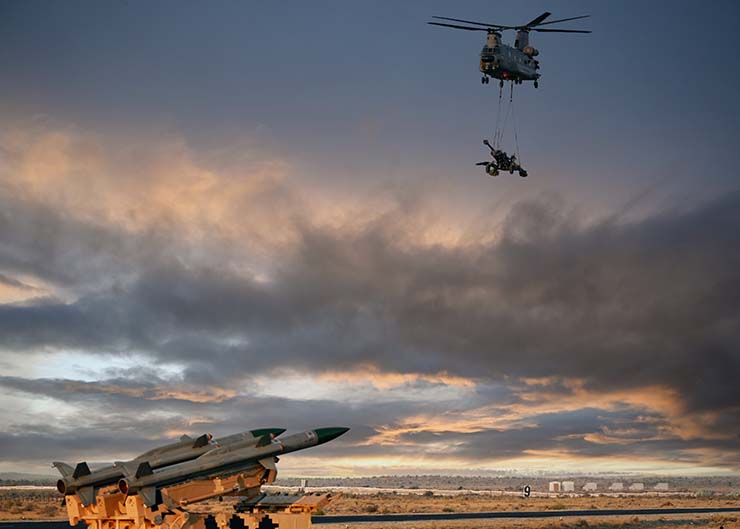
Night events displayed for the first time the capabilities of indigenous Light Combat Helicopter ‘Prachand’ wherein it neutralised designated target with rockets. This was followed by a Jaguar and Su-30 MKI dropping heavy calibre and area weapons at night showcasing the strategic bombing capability of the lAF. Remotely Piloted Aircraft carried out the bomb damage assessment of all targets that was live streamed to the operations centre and to the audience.
The event also included a free fall drop by the Akashganga team and flare dispensing by C-130J by night. In the spirit of jointness, a Tri-service band enthralled the audience with their tunes.
– The writer is a senior journalist and media consultant. The views expressed are of the writer and do not necessarily reflect the views of Raksha Anirveda.














